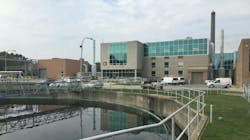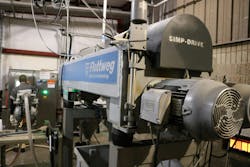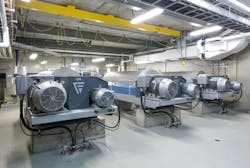3 waste handling trends that save time, money and the environment
Both industrial and municipal plants have a responsibility to the environment to properly process waste. Often, they work together to ensure that this happens.
“If an industrial plant feeds into a municipal plant, they need to ensure that toxicity levels are manageable by the municipality,” said Frank Scriver, managing director, Flottweg Separation Technology Canada, ULC. “Municipal plants then have the highest responsibility since the effluent from there must be ‘clean’ enough to prevent harm to the environment.”
Even with the many challenges, there are several trends in waste handling that can create viable solutions for savings in production time, operational costs and environmental strain.
1. Transport of solids. There are several operational costs that can impact a waste processing operation, including the transport of solids. “After a waste treatment plant has separated the solids from the liquid, the liquid is cleaned to a disinfected level that ensures safe reintroduction into the environment,” Scriver said. “Truthfully, many times this effluent is safe enough for human consumption (although many folks still cringe at this thought). The solids, however, will either be transferred to a landfill or, if treated further, it can be used as fertilizer.”
There are even opportunities to use biosolids as a source of energy when used as fuel for generators. “Since these solids need to be transferred, the overall mass and weight plays a huge role in the cost of the transfer,” Scriver added. “Essentially, water becomes the enemy. The dryer the biosolids, the lower your transfer costs. There are other costs in a waste process, such as polymer costs or energy consumption that can keep an operations manager awake at night, but the number one savings target is generally solids transfer costs.”
2. New technology innovations. Savings calculations require data, and most plants effectively keep these records. “Often, these are facts that are used to judge how well the plants are being managed,” Scriver explained. “However, there are occasions when new technology emerges that requires rethinking. Some technology innovations have such a quick ROI that the investment becomes a no brainer. These could be chemistry, process or mechanical innovations.”
3. Improved automation. Many plants are continuing to automate their processes. “Machines communicating with other machines is a trend that will continue to grow,” Scriver said. “Computers are making adjustments based on process sensors which ensure optimal operations. This requires manufactures of varying equipment to work together to find solutions that will optimize a plant’s efficiency. For example, centrifuges have been regarded as costly to operate. A misconception is that the high-speed spinning wears on the equipment quickly. When looking to separate a liquid from a solid there is no better technology that compares to the containments, efficiency and consistency of this machine.”
Success stories
The following are three real-world examples of how manufacturing plants are utilizing these trends to experience significant savings in their waste handling efforts.
Three-phase centrifuge produces sustainable separation solution
For JTM Food Group — a family-managed food processing company in Cincinnati, Ohio — producing low-fat, low-calorie products in an environmentally responsible, sustainable and energy-saving manner is the top priority. Thanks to an upgrade to a three-phase centrifuge, JTM can separate the wastewater generated into three components in one step during production — grease, water and solids. This allows the company to achieve a cleaner fat content, less wastewater and drier solids than ever before.
For JTM, that means cost savings due to reduced wastewater volume and added profits, since they can reuse solids as animal feed.
“We need to reduce the amount of water that we send to the city,” said Jerry Cramer, process consultant for waste treatment at JTM. “And we need to make that water quality as good as we can possibly get it.”
Dewatering removes the materials that are contaminating the water so JTM can either reuse them or recover them for some other purpose.
In three-phase separation, it is possible to separate two liquid phases from one solid phase at the same time. The different densities of the (immiscible) liquids and the solid mean that all three phases can be discharged simultaneously using Flottweg’s Tricanter.
For JTM Food Group, the service and dependability of the equipment, along with its performance, has made the difference in reaching its quality and sustainability goals.
Centrifuge system saves wastewater treatment plant more than $200K annually
Solvay is a wastewater treatment facility with two chemical plants on its Willow Island, West Virginia, site. Three other chemical plants feed into the activated sludge wastewater treatment facility, making it difficult to create a consistent sludge. The five sites produce around 3 million gallons of wastewater per day.
The plant used chamber presses for decades, but recently switched to a Flottweg centrifuge system that has provided immediate results. According to Solvay’s maintenance and wastewater treatment superintendent, the company now saves approximately $214,000 annually thanks to the effective, automated and easy-to-use equipment. In addition, the centrifuge system has decreased production time from 24/7 to just one 12-hour shift per day while also improving the quality of the sludge and reducing landfill mass.
“We have a lot of different batches here which change day-to-day, and month-to-month,” said the superintendent. “This makes it difficult to keep a healthy biomass. The biomass is constantly changing. We see many different food groups. The food can swing quickly, which makes it very difficult to develop a consistent sludge.”
This is a common challenge for treatment plants when there are batches from multiple sources and very little, if any, equalization.
To make a consistent sludge requires a consistent waste. “If everyone sends a consistent waste, then the bugs would acclimate to it,” the superintendent said. “You could grow a healthy bug that would settle. But when you constantly change the pH and the chemical feed, you have some bugs that are dying and other bugs that are increasing in population. This type of sludge is extremely difficult to dewater.”
When the solids level rises in a wastewater treatment plant, costs also rise. In the winter of 2017, the superintendent connected with Flottweg Separation Technology and was able to work within its pilot program on a rental agreement for centrifuge equipment with superior technology and service.
“The pilot unit originally came with a solid scroll, it was then exchanged for an open bodied (Xelletor) scroll,” he said. “We saw a huge improvement. The pilot unit was giving us solids at 19-20%. It was easy to run. You hit the start button and it began producing product right away. We began to run the open bodied (Xelletor) scroll from April to August and it was a step change. The product was flaky, and it was much easier to keep the centrate clean. It was at least 21% solids. That one or two percent makes a physical change in the way the sludge looks and the way it behaved.”
The Flottweg Separation Technology centrifuge system allowed the Solvay Wastewater Treatment Plant to reduce man hours used with the dewatering equipment, reduce operation time and tons of landfilled material, increase sludge consistency and reduce energy.
This system allowed Solvay to decrease operation time from 24/7 with full-time dedicated operators, to just one 12-hour shift per day. The centrifuge system decreased the need for additional manpower and also reduced the risk of injury for the operators.
The plant no longer needs to add fly ash to the centrifuge, which saves the cost of fly ash, hauling cost and tipping fees because the end product is lighter.
In total, the plant was able to see a ROI within a few months. After the first year in operation, the Flottweg system proved its worth by providing Solvay a net annual savings of more than $214,000. This number includes costs for Ash, Ash transport, landfill transport, disposal, polymer, rental, rental labor, rolloff boxes, rolloff truck, plastic liner, maintenance and electrical.
Sewage treatment plant saves $900,000 CAD per year
Greenway Wastewater Treatment Plant is the largest plant in the city of London, Ontario, Canada. It has a designed capacity of 170 million liters per day and a peak capacity of 255 million liters per day. It takes approximately two-thirds of the city of London’s wastewater flows.
Greenway’s disposal process is incineration. The treatment plant now utilizes Flottweg centrifuges to dewater the sludge to a solids content of about 26 percent. Additionally, ancillary fuel is not needed anymore, which results in a savings of nearly $ 900,000 CAD per year.
“Depending on the level of water content in the sludge more energy is required for more water content, and less energy is required for less water content,” said Greenway’s supervisor of operations. “Because the level of solids was much lower with the belt filter presses, it required us to use auxiliary fuel to maintain that energy level and the temperature in our fluidized bed.”
In 2012, Greenway installed three Flottweg C7E units. The process is operating 95 percent of the time, and two of the units are running at all times. These three machines are individually designed to accommodate 1,200 liters per minute of liquid flow, or 1,700 kg per hour of mass flow.
“With the centrifuges we can bring that solids content up to a level where we don’t have to use auxillary fuel to maintain those temperatures,” the supervisor of operations explained. “It runs without that fuel. In addition, polymer consumption actually is lower than we had anticipated. Originally, we had budgeted for a certain level with regard to polymer usage, and it is probably about 75 percent of what we originally anticipated.”
The biggest cost savings for the wastewater treatment plant came with the reduction in auxillary fuel (natural gas). The savings is in the neighborhood of $900,000 CAD per year.
“Sludge dryness can greatly affect overhead,” said the division manager at the Greenway plant. By reducing their sludge dryness from 24 to 25 percent, the plant was able to burn the sludge in incinerators without the aid of natural gas. They are currently treating approximately 17,000 dry tons of sludge per year.
After the sludge is burned, the Greenway plant hauls the leftover ash to a nearby landfill. Not every plant utilizes incineration processes, however. Some skip burning and haul the dewatered sludge cake directly to a landfill. In these instances, the transportation cost is heavily weighed against the dryness of the cake.
The changeover from belt presses to centrifuges was not entirely seamless. Polymer consumption increased; however, the added cost was more than offset by the gas savings. Also, centrifuge parts tend to be more expensive than belt press parts. This, however, is offset by the fact that there are fewer wear parts and therefore, repair is much easier.
With the transition to Flottweg’s centrifuges, the Greenway plant was able to meet the demands of its operational management, but also the low downtime desired by maintenance personnel. The system has helped them reduce costs and simplify operations.
About the Author
Daniel Lakovic
Business Development Manager for Flottweg Separation Technology Inc.
Daniel Lakovic is the Business Development Manager for Flottweg Separation Technology Inc. Daniel holds degrees BS in International Business and an MBA in Finance. He can be reached at [email protected].


